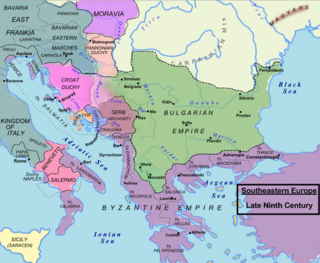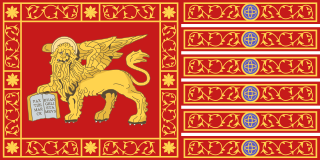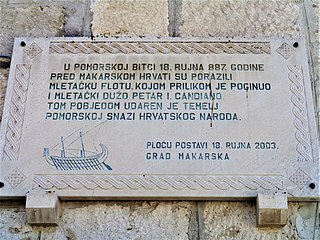Related Research Articles

Dalmatia is one of the four historical regions of Croatia, alongside Central Croatia, Slavonia and Istria, located on the east shore of the Adriatic Sea in Croatia.

Zadar ; historically known as Zara, is the oldest continuously inhabited city in Croatia. It is situated on the Adriatic Sea, at the northwestern part of Ravni Kotari region. Zadar serves as the seat of Zadar County and of the wider northern Dalmatian region. The city proper covers 25 km2 (9.7 sq mi) with a population of 75,082 in 2011, making it the second-largest city of the region of Dalmatia and the fifth-largest city in the country.
The Treaty of Rapallo was an agreement between the Kingdom of Italy and the Kingdom of Serbs, Croats and Slovenes in the aftermath of the First World War. It was intended to settle the Adriatic question, i.e. Italian claims over territories promised to the country, in return for its entry into the war, against Austria-Hungary; claims that were made on the basis of the 1915 Treaty of London. The wartime pact promised Italy large areas of the eastern Adriatic. The treaty, signed on 12 November 1920 in Rapallo, Italy, generally redeemed the promises of territorial gains in the former Austrian Littoral by awarding Italy territories generally corresponding to the peninsula of Istria and the former Princely County of Gorizia and Gradisca, with the addition of the Snežnik Plateau, in addition to what was promised by the London treaty. The articles regarding Dalmatia were largely ignored. There Italy received the city of Zadar and several islands. Other provisions of the treaty contained safeguards for the rights of Italian nationals remaining in the Kingdom of Serbs, Croats and Slovenes, and provisions for commissions to demarcate the new border, and facilitate economic and educational cooperation. The treaty also established the Free State of Fiume, the city-state consisting of the former Austro-Hungarian Corpus Separatum that consisted of Rijeka and a strip of coast giving the new state a land border with Italy at Istria.

The Kingdom of Dalmatia was a crown land of the Austrian Empire (1815–1867) and the Cisleithanian half of Austria-Hungary (1867–1918). It encompassed the entirety of the region of Dalmatia, with its capital at Zadar.
Ivan Karlović, also known as by his Latin name Johannes Torquatus, was the Count of Krbava. His life during critical periods of Hundred Years' Croatian–Ottoman War was marked by constant efforts to stop Ottoman conquests of Croatia, during which he held position of Ban of Croatia twice: from 1521 to 1524 and again from 1527 to 1531. He was also one of the Croatian magnates who participated in 1527 Election in Cetin.

The Stato da Màr or Domini da Mar was the Republic of Venice's maritime and overseas possessions from around 1000 to 1797, including at various times parts of what are now Istria, Dalmatia, Montenegro, Albania, Greece and notably the Ionian Islands, Peloponnese, Crete, Cyclades, Euboea, as well as Cyprus.

Nikodim Milaš was a Serbian Orthodox Church bishop in Dalmatia. He was a writer and arguably the greatest Serbian expert on Orthodox church law and the Slavic world. As a canon lawyer in Dalmatia, he defended the Serbian Orthodox Church against the State. He was a polyglot, fluent in German, Italian, Latin, Russian, Greek, and Old Slavonic, and an author of numerous books.
Jeronim Vidulić was a 15th-century Catholic priest and notary from Zadar, Venetian Dalmatia. He is best known for recording one of the earliest Petrarchist poems in Croatian, written using Glagolitic script.

The Adriatic Ionian Euroregion is a Euroregion comprising countries and their subdivisions bordering the Adriatic and Ionian Sea. The president of the organization is Nikola Dobroslavić, President of the Region of Dubrovnik. The Euroregion is formally established as a nonprofit organization according to the law of Croatia.
Arbanasi is an ethnic community in and around the city of Zadar region in northern Dalmatia region of Croatia who are of Albanian ethnic origin. They are traditional speakers of the Arbanasi dialect of Gheg Albanian. Their name is an obsolete way to say Albanians in Croatian and is the toponymy of the first Arbanasi settlement in the region, which today is a suburb of Zadar. In Albanian literature, they are known as "Albanians of Zadar".

The Dukagjini were a noble Albanian family which ruled over an area of Northern Albania and Western Kosovo known as the Principality of Dukagjini in the 14th and 15th centuries. They may have been descendants of the earlier Progoni family, who founded the first Albanian state in recorded history, the Principality of Arbanon. The city of Lezhë was their most important holding.

Italians of Croatia are an autochthonous historical national minority recognized by the Constitution of Croatia. As such, they elect a special representative to the Croatian Parliament. There is Italian Union of Croatia and Slovenia, in Croat Talijanska Unija, in Slovene Italijanska Unija, which is Croat-Slovene organization with main site in Fiume-Rijeka and secondary site in Capodistria-Koper of Slovenia.

The Duchy of Croatia was a medieval state that was established by White Croats who migrated into the area of the former Roman province of Dalmatia c. 7th century CE. Throughout its existence the Duchy had several seats – namely, Klis, Solin, Knin, Bijaći and Nin. It comprised the littoral – the coastal part of today's Croatia – except Istria, and included a large part of the mountainous hinterland as well. The Duchy was in the center of competition between the Carolingian Empire and the Byzantine Empire for rule over the area. Croatian rivalry with Venice emerged in the first decades of the 9th century and would continue through the following centuries. Croatia also waged battles with the Bulgarian Empire and with the Arabs; it also sought to extend its control over important coastal cities under the rule of Byzantium. Croatia experienced periods of vassalage to the Franks or to the Byzantines and of de facto independence until 879, when Duke Branimir was recognized as an independent ruler by Pope John VIII. The Duchy was ruled by the Trpimirović and Domagojević dynasties from 845 to 1091. Around 925, during the rule of Tomislav, Croatia became a kingdom.

Osman Bejtullah Agë Kuka, also known as Oso Kuka, was an Albanian border guard on the Ottoman-Montenegrin border. Surrounded by Montenegrin soldiers in a tower on the island of Vranjina, he blew it up, killing himself and many of the Montenegrin soldiers. In the following decades, he became a rallying figure of the Albanian independence movement and a much-celebrated character in multiple important works in Albanian literature.

Venetian Dalmatia refers to parts of Dalmatia under the rule of the Republic of Venice, mainly from the 15th to the 18th centuries. Dalmatia was first sold to Venice in 1409 but Venetian Dalmatia was not fully consolidated until 1420. It lasted until 1797, when the Republic of Venice fell to the forces of Napoleon Bonaparte and Habsburg Austria.
Anti-Croat sentiment or Croatophobia is discrimination or prejudice against Croats as an ethnic group and it also consists of negative feelings towards Croatia as a country.

Franjo Ksaver Tomašić was a Croatian baron and a lieutenant field marshal of the Austrian Empire's Army who served as a First Governor of Kingdom of Dalmatia between 1815 and 1831.

The Croatian–Venetian wars were a series of periodical, punctuated medieval conflicts and naval campaigns waged for control of the northeastern coast of the Adriatic Sea between the city-state of Venice and the Principality of Croatia, at times allied with neighbouring territories – the Principality of the Narentines and Zahumlje in the south and Istrian peninsula in the north. First struggles occurred at the very beginning of the existence of two conflict parties, they intensified in the 9th century, lessened during the 10th century, but intensified again since the beginning of the 11th century.

A period of Albanian piracy occurred from the 15th to the 19th centuries, during which Albanian pirates plundered and raided ships. These pirates were based mainly in Ulcinj, but were also found in Bar and Ragusa, and had connections with North Africa.
Jak Mark Suma was an Albanian diplomat. He was the vice consul of Venice and then Austria and a dragoman between them and the Ottoman Empire. He was the last vice consul of Venice in Shkodra in the 600-year presence of the maritime republic in the city. He was the son of Kolë Suma, one the first native doctors in the region. He came from a branch of the Albanian Suma family, a notable urban family of Shkodra since the middle ages. In 1778, Mahmud Pasha proposed to elect Suma as the vice consul of Shkodër. In his time as vice-consul of Venice he faced the increasing competition by the trade of Dulcigno to Venetian interests in Shkodër. Suma was personally responsible for transportation of products from Shkodër to Venice and would travel with the cargo to oversee the journey.
References
- ↑ Čoralić, Lovorka (2007). "The Albanian family Ginni in the sixteenth- and seventeenth-century histories of Dalmatia and Istria: a contribution to the study of communications along the East Adriatic Coast". Povijesni prilozi (in Croatian). 26 (33): 271–286. Retrieved 10 November 2019.
- 1 2 Riska, Albert (2013). "The Christian Saints in the (Micro)toponymy of Albania". Anglisticum Journal (IJLLIS) vol 2 issue 3. Pages 167-176. Page 174
- ↑ Durham, Mary Edith (1928). Some Tribal Origins, Laws and Customs of the Balkans. George Allen & Unwin. p. 65. ISBN 9780598768889 . Retrieved 10 November 2019.
- ↑ Coralic, Lovka (2004). ZADARSKI KANONIK – SKADRANIN GIOVANNI CAMPSI (UDK 929:659.3 G. Campsi Izvorni znanstveni rad ed.). Hrvatski institut za povijest Zagreb. Retrieved 10 November 2019.
{{cite book}}: CS1 maint: location missing publisher (link) - ↑ Čoralić, Lovorka (2007). Albanska obitelj Ginni u povijesti Dalmacije i Istre (xvi. i xvii. st.) – prilog poznavanju komunikacija duž istočnojadranske obale. UDK 929.5 Ginni, obitelj “15/16” 94 (497.5 Dalmacija) “15/16” Izvorni znanstveni rad Primljeno: 21. svibnja 2007. Prihvaćeno za tisak: 3. prosinca 2007.: Hrvatski institut za povijest Opatička 10 10000 Zagreb Republika Hrvatska. pp. 1–17. Retrieved 10 November 2019.
{{cite book}}: CS1 maint: location (link)